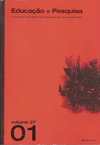The production of narrative texts in pairs: reflections on the interaction process
DOI:
https://doi.org/10.1590/S1517-97022001000100003Keywords:
Creation of texts, Interaction, Primary educationAbstract
The article analyzes the interaction process between pairs of pupils in the production of narrative texts. The choice of this issue is linked to the basic conception that the creation of texts is a cognitive and social activity that entails a coordination of actions and decisions of various types. Knowledge is necessary about the situation of immediate interaction, about the cultural practices, the text genre, and about the formal linguistic aspects. Thus, the article defends the idea that working in pairs can promote the awareness of decisions to be made, because conflicting ideas de-automate the task of writing. It also argues that the interaction can make children exchange information and test them during the production of the text, as well as to share strategies to coordinate actions. Activities were carried out with a third-year class (Primary School in Recife, 21 children aged 8 to 13) involving individual as well as pair writing of news, letters and short stories. The results show that the texts produced in pairs were better than individual texts for pairs of asymmetric (weak-average) and symmetric (average-average) arrangement; the same effect was not noticeable in pairs of (weak-weak) symmetric arrangement. Analyses of the protocols reveal that, when interacting, children negotiate information and strategies of text creation, and that they display various types of work dynamics that may include a clear division of tasks or a continuous negotiation in each part of the text created.Downloads
Download data is not yet available.
Downloads
Published
2001-06-01
Issue
Section
Articles
License
Authors assume exclusive responsibility for the concepts expressed in their articles, which do not necessarily reflect the journal’s opinion.
Permission to photocopy all or part of the material published in the journal is granted provided that the original source of publication be assigned.
How to Cite
The production of narrative texts in pairs: reflections on the interaction process . (2001). Educação E Pesquisa, 27(1), 27-45. https://doi.org/10.1590/S1517-97022001000100003



